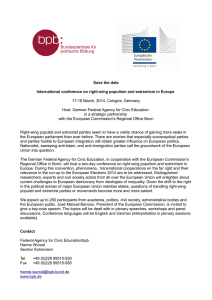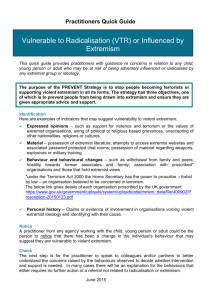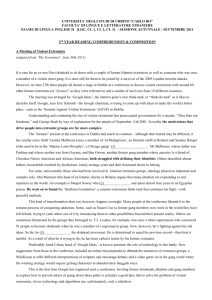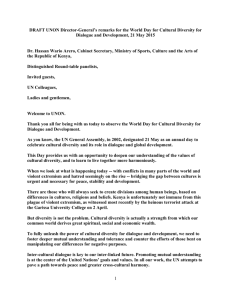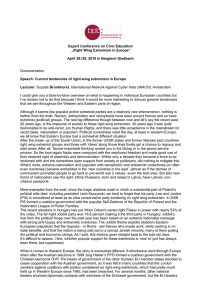Problems of Ethno-Confessional Extremism in Russia as a
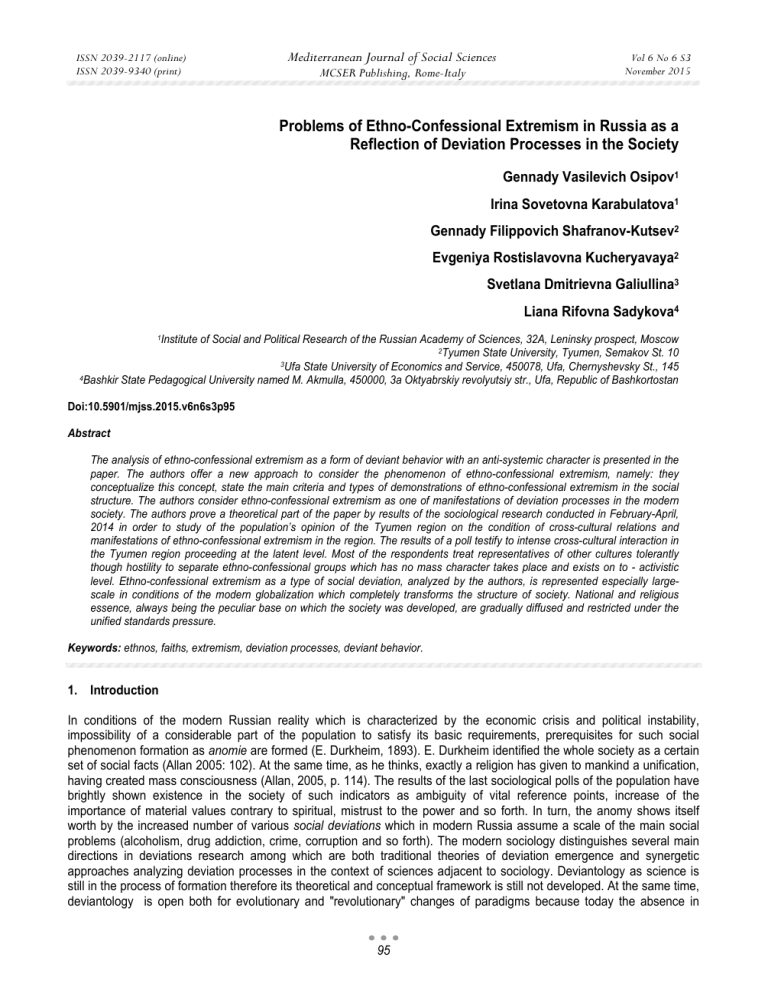
ISSN 2039-2117 (online)
ISSN 2039-9340 (print)
Mediterranean Journal of Social Sciences
MCSER Publishing, Rome-Italy
Vol 6 No 6 S3
November 2015
Problems of Ethno-Confessional Extremism in Russia as a
Reflection of Deviation Processes in the Society
Gennady Vasilevich Osipov
1
Irina Sovetovna Karabulatova
1
Gennady Filippovich Shafranov-Kutsev
2
Evgeniya Rostislavovna Kucheryavaya
2
Svetlana Dmitrievna Galiullina
3
Liana Rifovna Sadykova
4
1 Institute of Social and Political Research of the Russian Academy of Sciences, 32A, Leninsky prospect, Moscow
2 Tyumen State University, Tyumen, Semakov St. 10
4
3 Ufa State University of Economics and Service, 450078, Ufa, Chernyshevsky St., 145
Bashkir State Pedagogical University named M. Akmulla, 450000, 3a Oktyabrskiy revolyutsiy str., Ufa, Republic of Bashkortostan
Doi:10.5901/mjss.2015.v6n6s3p95
Abstract
The analysis of ethno-confessional extremism as a form of deviant behavior with an anti-systemic character is presented in the paper. The authors offer a new approach to consider the phenomenon of ethno-confessional extremism, namely: they conceptualize this concept, state the main criteria and types of demonstrations of ethno-confessional extremism in the social structure. The authors consider ethno-confessional extremism as one of manifestations of deviation processes in the modern society. The authors prove a theoretical part of the paper by results of the sociological research conducted in February-April,
2014 in order to study of the population’s opinion of the Tyumen region on the condition of cross-cultural relations and manifestations of ethno-confessional extremism in the region. The results of a poll testify to intense cross-cultural interaction in the Tyumen region proceeding at the latent level. Most of the respondents treat representatives of other cultures tolerantly though hostility to separate ethno-confessional groups which has no mass character takes place and exists on to - activistic level. Ethno-confessional extremism as a type of social deviation, analyzed by the authors, is represented especially largescale in conditions of the modern globalization which completely transforms the structure of society. National and religious essence, always being the peculiar base on which the society was developed, are gradually diffused and restricted under the unified standards pressure.
Keywords: ethnos, faiths, extremism, deviation processes, deviant behavior.
1.
Introduction
In conditions of the modern Russian reality which is characterized by the economic crisis and political instability, impossibility of a considerable part of the population to satisfy its basic requirements, prerequisites for such social phenomenon formation as anomie are formed (E. Durkheim, 1893). E. Durkheim identified the whole society as a certain set of social facts (Allan 2005: 102). At the same time, as he thinks, exactly a religion has given to mankind a unification, having created mass consciousness (Allan, 2005, p. 114). The results of the last sociological polls of the population have brightly shown existence in the society of such indicators as ambiguity of vital reference points, increase of the importance of material values contrary to spiritual, mistrust to the power and so forth. In turn, the anomy shows itself worth by the increased number of various social deviations which in modern Russia assume a scale of the main social problems (alcoholism, drug addiction, crime, corruption and so forth). The modern sociology distinguishes several main directions in deviations research among which are both traditional theories of deviation emergence and synergetic approaches analyzing deviation processes in the context of sciences adjacent to sociology. Deviantology as science is still in the process of formation therefore its theoretical and conceptual framework is still not developed. At the same time, deviantology is open both for evolutionary and "revolutionary" changes of paradigms because today the absence in
95
ISSN 2039-2117 (online)
ISSN 2039-9340 (print)
Mediterranean Journal of Social Sciences
MCSER Publishing, Rome-Italy
Vol 6 No 6 S3
November 2015 deviantology of the settled terminology, the steady structure, the conventional characteristics of its subject is obvious.
We define deviation processes as the course, development of deviations with its consecutive change of conditions.
By the term "deviance" is understood the condition of the subject participating in the deviation process, and by the term
"deviant behaviour" - alloprinig the subject in a concrete type of the deviation process.
The main factors promoting the increasing deviation processes are leveling of the traditional culture bases, the increasing unemployment, poverty, the increasing corruption, the deterioration of a social and economic situation in the country owing to the global crisis and opposition of the West in conditions of a new "cold war", migration, strengthening of the nationalist and extremist and terrorist sentiments in the world.
In the sphere of cross-cultural interaction of the population deviations are fully shown in the form of ethno-religious extremism. In this case, this promotion and excitement of racial and religious discord, the public justification of terrorism or its realization, violation of rights, freedoms and legitimate interests of the person depending on his national, religious or language identity and so forth (Federal law "On counteraction of the extremist activity ʋ .114, 2002).
In conditions of social and demographic transformation of the modern Russian society structure in a situation of a new sharpening of relationship of Russia, the European Union and the USA, the instability of market relations, the problem of deviation processes in the world takes on increasing theoretical and practical importance. The restrained ethno-religious identification amplifies causing a splash in religious consciousness, ethno-national orientations, interests, national and cultural isolation, numerous ethno-religious collisions (Manapova, 2010).
There is a steady correlation between the growth of society extremist moods and crisis condition. Transition periods when norms, which are traditional for the society, have become outdated and depreciated, and new ones were not still created, are always periods of the general instability. And therefore the people losing from changes and feeling uncertainty in their face address to fundamental human values, frequent in their radical forms.
2.
Materials and Methods
The modern synergetic approach of the ethno-confessional extremism research as a form of deviation processes also includes the analysis of social behavior and psychology in deviation change that enriches understanding of deep reasons of deviation as the phenomena of the public life. The philosophy of deviantology is based on the relativity of "Good" and
"Evil" concepts in real life, "where vice is bound with virtue and where good causes evil, and evil - good" (Hegel, 1971, p.
574).
The theoretical and methodological basis of the present research is based on classics of sociological concepts in the research of deviation processes in the society developed in due time by M. Weber, E. Durkheim, K. Marx, R. Merton,
P. Sorokin, etc.
Being guided by the typology of deviations given by Mendelevich V. I. (2005), the authors defined the main types of demonstrations of ethno-confessional extremism in the public structure in the modern Russian society, namely:
1) Individual and group extremist demonstrations. An individual type of extremism does not depend on the influence of people around. It is especially peculiar to representatives of youth who often break rules of law and morals with the purpose to oppose itself to the society, confronting "with all and sundry", wishing to approve its identity. The principle of group pressure and tolerance to this pressure with which the complete acceptance of group views is combined with suppression of own doubts in correctness, normative essence of behavior is the basis of a group type of extremism;
2) Steady and planned, unstable and spontaneous extremist demonstrations. The first type differs in the small duration of existence of deviant behavior, often it is connected with group pressure and impossibility to be out of a group. It is possible to carry such acts of ethno-confessional extremism to them as spontaneous beatings of representatives of other nationalities on the streets, the cross-cultural conflicts on everyday reason. Such forms of deviant behavior which tend to long existence and weak dependence on external influences belong to continuous extremist demonstrations. They possess such characteristics as regimentation, defined manner;
3) Structured and unstructured extremist demonstrations. Structured (organized) extremist demonstrations are understood as a group form of deviant behavior within which the roles of all its participants are accurately determined. For example, sectarianism, membership in a terrorist group means the unity and structure.
Unstructured (poorly organized) kind of extremist demonstrations are characterized by absence of the hierarchical relationship, regulation of acts;
4) Latent and open extremist demonstrations. The extremism in its open form consists in specific aggressive actions and violence over representatives of other cultures. For realization of the purposes his adherents address to the use of extraordinary, violent and destructive acts, i.e. is to terrorist methods. The latent
96
ISSN 2039-2117 (online)
ISSN 2039-9340 (print)
Mediterranean Journal of Social Sciences
MCSER Publishing, Rome-Italy
Vol 6 No 6 S3
November 2015 extremism exists at the to-activistic level in the form of views, believes and aims. It is widespread in the society much more widely than open demonstrations of aggression and hat ɭ and is a marker of the hidden intolerance and a factor of the social tension.
Thus, criteria of extremism in ethno-confessional interaction can be: 1) violations of rights and freedoms of other members of the society; 2) destabilization of the existing social system (or its provocation); 3) the intra personal conflict caused by inability and unwillingness to accept traditions and norms of representatives of other ethnos and faith.
On February-April, 2014 a group of authors conducted the sociological research directed on studying of the population’s opinion of the Tyumen region on the condition of cross-cultural relations and demonstrations of ethnoreligious extremism in the region. Within the research 600 inhabitants of the area aged from 18 till 65 years were interrogated, they were offered to answer 36 questions.
Priority to carrying out the research we have used methods which settled in modern sociology: questioning, interviewing (including, deep), content analysis, method of a typologization of the empirical and statistical information, an expert poll, a cluster and factorial analysis.
Deviation processes research is impossible without support on the information and empirical factual base in which entered: a) title state acts, laws, by-laws, programs; b) Constitution (Basic law) of the Russian Federation; c) Code of criminal procedure of the Russian Federation; d) data of criminal statistics of the All-Russian Research Institute of the
Ministry of Internal Affairs; e) data of the state and regional statistics; e) the data taken from mass media; g) normative documents of the Ministry of Internal Affairs of Russia; h) data taken from questionnaires and other polls.
3.
Results
Competent permission of ethnic and religious conflicts demands the deep analysis of socio-political, social and economic and welfare reasons of their emergence.
As respondents think, the problem of ethno-confessional extremism is actual for the Tyumen region that is caused by the real increase of ethnic and religious intolerance in Russia and all over the world. Estimating the condition of crosscultural interaction in the area, most of respondents chose a version of the answer "Externally everything is quiet, but intensity at the everyday level is felt" (figure 1). Thus, considerable divergences of representatives’ answers of the
Russian nationality and ethnic minorities are noticeable. The last give more negative assessment to the condition of cross-cultural interaction in the Tyumen region (versions of the answer "There is obvious intensity, there are prerequisites for emergence of conflicts" and "Cross-cultural conflicts take place" chose 6,7% and 18,6% of respondents of the Russian nationality, and 12,5% and 20,3% of representatives of ethnic minorities).
Figure 1 – Distribution of answers to the question "How do you estimate the condition of the cross-cultural relations in the
Tyumen region?"
To the question of the attitude towards representatives of other religions and nationalities "What is your usual reaction in cases when you meet representatives of other religion or nationality?" 60,7% of respondents answered (figure 2) "I do not pay any attention to their features; I treat them quietly", 16,6% of respondents chose a variant "I show my interest". Thus,
20,4% of respondents chose a variant "I treat them fear, but I try to hide my feelings". The answers to these questions confirm a hypothesis that most of the population treats representatives of other cultures tolerantly, but also distribution of answers shows existence of hidden intolerance in the society of the Tyumen region which is the prerequisite of ethnoconfessional extremism emergence.
97
ISSN 2039-2117 (online)
ISSN 2039-9340 (print)
Mediterranean Journal of Social Sciences
MCSER Publishing, Rome-Italy
Vol 6 No 6 S3
November 2015
Figure 2 – Distribution of answers to the question "What is your usual reaction in cases when you meet representatives of other religion or nationality?"
Most of respondents faced demonstrations of the national hostility in relation to other people (64% who answered), and only 9% of respondents - in relation to themselves. Thus, representatives of ethnic minorities personally meet demonstrations of the ethno-religious hostility much more often (among people who answered "Yes, I have faced in relation to myself" - 6,7% of Russians and 20,8% of representatives of ethnic minorities).
Among the respondents anyway facing demonstrations of the ethno-religious hostility, the absolute majority to the question "If yes, what these demonstrations consist in (specify all suitable versions to the answer)" (figure 3) has answered "Roughness and insulting in public places" (76,8%), "Disrespectful relation of schoolmates, fellow students, fellow workers (offensive nicknames, jokes, etc.)" (42,6%) and "Hooligan actions, acts of vandalism (inscriptions on fences, slogans on cars, etc.) " (45%). Thus, specifics of ethno-confessional extremism are in the Tyumen region consist in the latent form, exist in the form of ideas and moods. Danger of latent extremism consists in that it has a property to be broadcast from generation to generation, paving the way for obvious extremism emergence. Thus, ethno-confessional conflicts in the Tyumen region happen constantly but because they take place at the everyday level and proceed latent, the impression about stability of cross-cultural interaction in the Tyumen region is made. Also specifics of ethnoconfessional extremism in the area are its Islamic and Salafi character and also multifold character because of territorial specifics and the difficult structure of the population.
Figure 3 – Distribution of answers to the question of ethno-religious hostility demonstrations
The inflow of migrants to the Tyumen region is estimated by the population negatively (figure 4), especially concerning migrants of such nationalities as the Tajiks and Azerbaijanians. Most of the population supports restriction of their entrance to the area. Among respondents stereotypes about a danger of migrants and their hostility to the local population, and also the irrational hostility to their language, manners and appearance are widespread (that is defined by a biological nature of xenophobia).
98
ISSN 2039-2117 (online)
ISSN 2039-9340 (print)
Mediterranean Journal of Social Sciences
MCSER Publishing, Rome-Italy
Vol 6 No 6 S3
November 2015
Figure 4 – Distribution of answers to the question concerning the relation to the migrants’ flow to the Tyumen region
The Muslim extremist organizations are estimated by the population and experts as the most socially dangerous though most of respondents do not see connection between Islam and extremism (figure 5). It is explained by from the fact that it is most often told about Islamic groups to mass media, and they made the greatest number of loud acts of terrorism for the last decades. Thus, adherents of Islam are least inclined to consider the religion predisposed to extremism. As a rule, it is used by individuals and groups for the characteristic of others, but not theirselves.
Figure 5 – Distribution of answers to the question of communication between religious extremism and Islam depending on religious accessory of a respondent
Also it was offered to respondents to answer the questions connected with a strategy of management of cross-cultural interaction in the Russian Federation and the region (figure 6). The majority of the answered considers that the national policy of the Russian Federation must be "Tolerant attitude towards representatives of cultural minorities as to citizens of the Russian Federation, but without providing to them the special rights allocating against other nationalities". The absolute majority of respondents (81%) understand the principle of "equality of the people in the Russian Federation" as
"equal rights for representatives of all nationalities" (among them 81% of Russians and 85,4% of representatives of ethnic minorities); 12% of respondents consider that this principle means "Infringement of rights of representatives of the
Russian nationality as the leading ethnos" (12% of Russians and 2% of representatives of ethnic minorities).
99
ISSN 2039-2117 (online)
ISSN 2039-9340 (print)
Mediterranean Journal of Social Sciences
MCSER Publishing, Rome-Italy
Vol 6 No 6 S3
November 2015
Figure 6 – Distribution of answers to the question of the national policy of the Russian Federation depending on a respondent's nationality
Thus, distribution of answers to the matters confirms a hypothesis that the most part of the population supports the strategy of soft multiculturalism in the governing of cross-cultural relations in Russia. As it was supposed, for the absolute majority of respondents (74%) the main source of information on the condition of cross-cultural interaction and measures of its strengthening undertaken in the Tyumen region are the Internet (74%), television (53,5%), and also friends and acquaintances (46,7%). Also there were made a conclusion that for education of the population in questions of ethnoconfessional tolerance and patriotism, it is necessary to use various means of informing, depending on the desirable audience. Control over the Internet and carrying out in it propaganda activities (Kobersy et al., 2015), first of all, are necessary for the work with youth. The senior generations will gather necessary information from newspapers, magazines and television.
Measures for stabilization of the cross-cultural relations and counteraction to extremism in the Tyumen region cannot be defined as effective because most of the population estimates them as "satisfactory" or absolutely are not informed about them. Among actions for prevention of ethno-confessional extremism and education of patriotism respondents distinguish such as "exhibitions and expositions in museums" and "youth festivals", they are the most visited.
As the population thinks, in the Tyumen region acts of ethno-confessional extremism can take soon place (To the questionnaire question " Are acts of extremism in the Tyumen region and collisions on the ethno-confessional soil soon possible?" variants "Possible" and " Possible, but improbable" were chosen by 30% and 39,7% of respondents respectively). Thus, representatives of ethnic minorities give more negative assessment of the condition of ethnoconfessional relations.
The research results show very intense cross-cultural interaction in the Tyumen region. In conditions of harmonious cross-cultural interaction in the world outlook aims of the personality prevails no tendencies of ethnocentrism and xenophobia, but tolerance, mutual respect and legal consciousness. The most effective activities according to the prevention of ethno-confessional extremism are statement of the competent ethno-confessional education and the use of means of informing the population answering to inquiries of the desirable audience. Monitoring of mass media and the
Internet regarding detection of data on violation of the legislation on extremism, publicity of punishments for these violations, and also carrying out the sociological researches of an ethno-confessional situation in the area are of special importance.
4.
Discussion
Proceeding from G. Zimmel's theory, social harmony means incomplete absence of conflicts, or the society would lose the movement and structure, and rather their competent permission (Kozer, 2008; Maybuty-Lewis, 2002; Zamaletdinov, et al 2014; Ryazantsev, et al, 2014 & Shakil, 2015).
This thesis has the reflection in the sphere of cross-cultural interaction of the population in which full overcoming of disagreements completely impossible. It is explained by such phenomenon as xenophobia which, according to many
100
ISSN 2039-2117 (online)
ISSN 2039-9340 (print)
Mediterranean Journal of Social Sciences
MCSER Publishing, Rome-Italy
Vol 6 No 6 S3
November 2015 sociologists and anthropologists, has a biological nature because exactly the instinct which is its bases caused the principles of the organization of tribal formations. First of all, it is rejection of all stranger, unusual, unfamiliar. Moreover, there is in the society a tendency to judge foreign cultures from a position of superiority its own. This phenomenon is called ethnocentrism (Russell, 2013). American psychologists M. Bruer and D. Campbell have pointed out its main indicators: a) perception of elements of own culture (norms, roles and values) as natural and correct, and elements of other cultures as unnatural and wrong; b) consideration of own customs as universal; c) representation that for the person is natural to cooperate with members of own group, to help them, to prefer own group, to be proud of it and not to trust and even to be at enmity with others (Brewer & Campbell, 1976). So, the largest number of negative and estimated stereotypes appeared where ethnic groups were long time in the condition of the competition, conflict and hostility. A large number of negative and estimated ethnic stereotypes in colloquial English is explained by historical reasons: active international contacts of Great Britain, the fight for territories, colonization, slaveholding in the USA and immigration in the
USA. Almost all people to which British and Americans of the Anglo-Saxon origin have being contacted, since XVII century, have got pejorative ethnic nicknames: Irish, Germans, Dutches, French, Italians, Spaniards and Portuguese,
Latin Americans, Jews, Hindus, Chinese, Koreans, Vietnamese, Japanese, Eskimos, Indians and representatives of a black race. The steadiest and strong ethnic prejudices and, respectively, ethnic invectives in English have arose to those people which were during certain periods the most dangerous economic competitors.
For example, the negative image of French as thoughtless and vulgar nation has generated the greatest number of ethnic stereotypes with a vulgar connotation in colloquial English: French disease - venereal disease, esp. syphilis;
French stuff - pornografy; any unusual sexual activity; French revolution - the movement for homosexual rights; French handshake - a form of handshake signifying sexual interest; French embassy - a location with homosexual activity;
French postcard - an erotic picture postcard.
So, the texts of modern American newspapers and magazines in overwhelming number of cases have the politically correct lexicon which was widely adopted and recorded in the majority of explanatory dictionaries. Some of these words and expressions, such as Native American, Asian-American, actually forced out in the journalese speech used earlier Indian, Oriental, but a certain quantity is used along with their "incorrect" equivalents: African American and black, Latino and Hispanic. A significant amount of politically incorrect terms can be explained by the fact that such words as ethnonyms black and Hispanic still meet a language standard of English. In publications of the Russian press the term
"political correctness" is often treated as the reality inherent mostly to the United States or other countries of the West and affecting the Russian culture only to a certain extent. In Russian it is possible to rank to the politically correct lexicon only a small amount of euphemisms a big part of which, in turn, is foreign-language borrowings. Some of these lexical units were met quite often - the words "Afro-American", "black" replace the word "Negro" at designation of black residents of the USA. In general, as the analysis of newspaper texts testifies, in Russian is not observed so large-scale language innovations which occurred in English of the last decades under the auspices of overcoming of xenophobia and racial prejudices. There are pointed out two types of ethnocentrism: 1) kind (flexible) when there are attempts to understand other culture and when it does not extend on all spheres of the society activity; 2) aggressive (nonflexible) when to judge other cultureit is necessary to pay attention not only to own values, but also to try to impose them to others (Bodalev,
2011). Such social phenomena as xenophobia and militant ethnocentrism quite often become the instrument of achievement of political goals and are prerequisites of emergence of extremist demonstrations in cross-cultural interaction of the population (Karabulatova, 2013). At the present stage there is the high interest to the problem of ethnoconfessional extremism in the scientific community, but, despite it, in sociological science there is still no unified systematized theory which can form the basis for overcoming the practical problems in cross-cultural interaction of the population.
Along with it, in legal and scientific literature there is also no standard definition of the concept "ethno-religious and
/ or ethno-confessional extremism". More often in sociological and philosophical works the terms "religious extremism"
(A.V. Zhuravsky, V.A. Burkovskaya, Z.S. Arukhov, A.A. Nurullayev, A.M. Verkhovsky, M. Ya. Yakhyaev, etc.) and "ethnic extremism" (M.P. Kleymenov, V.P. Babintsev, L.V. Baeva, A.A. Burkov. A.M. Verkhovsky, etc.) are exposed to the development. The works of such authors as O. A. Rusanova, Yu.M. Antonyan, D. V. Novikov, etc. are devoted to the problem of ethno-religious extremism. Contents of these concepts are quite often extremely vague, mention private sides of the phenomena, but do not integrate all its properties. As a group of authors thinks, the use of the concept "ethnoconfessional extremism" because of deep interrelation of ethnic and religious factors which is traced since the beginning of the human history and the period of formation of ethnic communities is reasonable represented (Grigorenko, 2014). In this regard we will give the author's conceptualization of this term.
Extremism on the ethno-religious soil is one of elements in the structure of extremeness. Social extremeness is the compelled or spontaneous social activity, a form of the intensive activity - staying on the verge of exhaustion of resources
101
ISSN 2039-2117 (online)
ISSN 2039-9340 (print)
Mediterranean Journal of Social Sciences
MCSER Publishing, Rome-Italy
Vol 6 No 6 S3
November 2015 of the society and the person activity. Extremeness as a carrier of new cultural and valuable contents and a form of the intensive activity is wanted in conditions of uncertainty and social instability (Volkova, 2011).
It is obvious that social extremeness is substantially close to radicalism. Radicalism is an aspiration to bring political or other opinion to its final logical and practical conclusions without making any compromises. Radicalism should be interpreted as a reaction of these or those social subjects to critical, deadlock or extreme situations which they meet during the historical process (Yakhjyaev, 2013). Also as well as radicalism, extremeness can be constructive and destructive.
Constructive extreme demonstrations in cross-cultural interaction have the internal logic, are caused by the need and submit to regularities. They are directed on the high-quality, progressive transformation of the existing social system
(Karepova, et al, 2015; Karabulatova, et al, 2015; Ostrovskaya, et al, 2015; Ryazantsev, et al 2015 & Khachmafova, et al,
2015). To such extreme demonstration it is possible to refer the fight of ethnoses for a survival during the periods of discrimination, genocide, globalization and migrations (Karabulatova & Zinchenko, 2014; Pismennaya, et al, 2015;
Karabulatova & Akhmetova, 2015 & Karabulatova & Polivara, 2015). Their highest demonstration is the social revolution
(Dil, 2013 & Aristova, 2013). Destructive extremeness is always noted by egocentrism and willfulness. It is always accompanied by aggression and aggression, thus - aggression is an action of the person directed on harming another, - ada aggression is rather a readiness for such actions (Volkov, 2011; Vekhov, 2009 & Gabdrafikov, et al, 2015). Kinds of destructive extremeness are fundamentalism, fanaticism and extremism.
In our opinion, the essence of ideology of fundamentalism consists in that on order to return to the old social regime or to preserve existing social orders, having frozen, having stopped the process of progressive changes.
Fundamentalism arises in conditions of the crisis of any movement and, as a rule, resists, including violent means, to the process of changes, updating. Fanaticism is aimed at the radical transformation of the existing society according to the utopian ideological program.
Fanaticism and fundamentalism is two ways of subjects’ reaction to extreme social situations. They can pass one into another and merge with each other, act together. In its extreme forms fanaticism and fundamentalism degenerate in extremism (Yakhyaev, 2013)
5.
Conclusion
Considering the extremism nature as social deviation, it is possible to make a conclusion that ethno-confessional extremism is a special type of social deviation which is characterized by commitment to extreme views and measures in aspiration to reorganize the existing way of the society in combination with fanatical and fundamentalist religious, nationalist and political views. The consequences of such social phenomenon as ethno-religious extremism are unambiguously negative because they have brightly pronounced anti-system character. The example is the modern crisis in Ukraine provoked by extensive nationalist extremist performances which as a result have led to the development of separatist sentiments.
Regional specifics of ethno-confessional extremism as the deviation process are caused, in our opinion, by a geographical position of a concrete region, history of the edge development, a modern regional demographic situation, and also the quality of the social and economic development of a region for the population life.
References
Federal Law « On counteraction of the extremist activity» from 27 June 2002 ʋ 114-FZ. Approved by the Soviet of the Federation. URL: http://base.consultant.ru/cons/cgi/online.cgi?req=doc;base=LAW;n=148972 (accessed date: 01.02.2014).
Allan, D.K. (2005) Explorations in Classical Sociological Theory: Seeing the Social World. Published January 12th 2005 by Sage
Publications (CA), pp. 448.
Aristova, A.V. Religiozny terrorizm v informatsionnuyu epokhu // Internet-magazine «Protestant». URL: www.gazetaprotestant.ru
(accessed date: 11.08.2013).
Bodalev, A.A. (2011) Etnotsentrizm. Psihologiya obshheniya. Encyclopaedia. M.: Publishinh house «Kogito-Centr». URL: http://vocabulary.ru/dictionary/1095/word/yetnocentrizm (accessed date: 06.03.2014).
Brewer, M.B. & Campbell, D.T. (1976) Ethnocentrism and intergroup attitudes: East African evidence [Text] / M.B. Brewer, D.T.
Campbell.
Bricheva, M.M., Nescheretova, T.T. & Bersirova, A.K. (2015) Linguopragmatic Aspect of "Search for the Ideal" in the Discourse of
Female Fiction as a Reflection of Matrimonial-Demographic and Sexual Behavior in Contemporary Russian Society. Review of
European Studies. 2015. Vol. 7. No 6 (2015). pp.: 35-45.
Vehov, I.V. (2009) Ekstremizm kak objekt sotsiologicheskogo issledovaniya // Proceedings of the Herzen State Pedagogical University.
102
ISSN 2039-2117 (online)
ISSN 2039-9340 (print)
Mediterranean Journal of Social Sciences
MCSER Publishing, Rome-Italy
Vol 6 No 6 S3
November 2015 ʋ 111. pp. 284-289.
Volkova, N.G. (2011) Ekstremalnost v obshhestve riska: avtoref. dis. … cand. of Ph.sc. Saratov. pp. 17.
Hegel, G.V. (1971) Works of various years. 2 volumes. M. pp. 544.
Gabdrafikov, I.M., Karabulatova, I.S., Khusnutdinova, L.G. & Vildanov, Kh.S. (2015) Ethnoconfessional Factor in Social Adaptation of
Migrant Workers in the Muslim Regions of Russia. In the: Mediterranean Journal of Social Science. 2015. Vol 6, No3,
Supplement 4, May 2015. pp. 213-223.
Grigorenko, Yu.A. (2014) Natsionalnoe i religioznoe: problema vzaimootnosheny // Vestnik Russkoi hristianskoi gumanitarnoi akademii. ʋ 2. pp. 260-267.
Dil, V.A. (2013) Sovremenny ekstremizm i formy ego preodoleniya: sotsiokulturnyi aspekt: avtoref. dis. ... cand. Ph. sc. Tomsk. URL: http://www.dslib.net/teorja-kultury/sovremennyj-jekstremizm-i-formy-ego-preodolenija-sociokulturnyj-aspekt.html (accessed date:
30.05.2014).
Karabulatova, I.S. (2013) The problems of linguistic modeling of new Eurasian linguistic personality in multilinguistic and mental environment (by example of onomasphere) // Middle-East Journal of Scientific Research 17 (6): 791-795.
Karabulatova, I.S. & Zinchenko, A.A. (2014) Tyumen Nenets Sacral Childhood Culture as an Ethnolinguistic Mechanism of Preserving
Ethnic Identity // Middle-East Journal of Scientific Research 20 (11): 1344-1347.
Kobersy, I., Barmuta, K., Muradova, S., Dubrova, L., & Shkurkin, D. (2015). The System of the Methodological Principles of Management of Enterprise Development. Mediterranean Journal Of Social Sciences, 6(3 S4), 25. Retrieved from http://www.mcser.org/ journal/index.php/mjss/article/view/6707
Karabulatova, I.S., Khachmafova, Z.R., Bricheva, M.M., Nescheretova, M.T. & Bersirova, A.K. (2015) Linguopragmatic Aspect of
"Search for the Ideal" in the Discourse of Female Fiction as a Reflection of Matrimonial-Demographic and Sexual Behavior in
Contemporary Russian Society. Review of European Studies. 2015. Vol. 7. No 6 (2015). pp.: 35-45.
Karabulatova, I.S. & Polivara, Z.V. (2015) Intraethnic installation of Ukrainian Labour migtants in the preservation of linguistic and cultural identity. In the: Mediterranean Journal of Social Science. 2015. Vol 6, No3, S2, May 2015. pp.: 142-148.
Karabulatova, I.S. & Akhmetova B.Z. (2015) Characteristics of Social-Cultural Vitality of Modern Russian Settlements of the Former
Gorky Line of Kazakhstan. In the: Mediterranean Journal of Social Science. 2015. Vol 6, No3, S4, May 2015. pp.201-206.
Karepova, Svetlana Gennadievna, Karabulatova, Irina Sovetovna, Novikov, Vladimir Sergeevich, Klemovitsky, Sergey Veniaminovich,
Stratan, Dmitry Ivanovich & Perova, Anastasia Evgenievna. New Approaches to the Development of Methodology of Strategic
Community Planning. In the: Mediterranean Journal of Social Science. 2015. Vol 6, No3, S.6. pp.357-364.
Khachmafova, Z.R., Karabulatova, I.S., Luchinskaya, E.N. & Osipov, G.V. (2015) Gender Features of Discourse of Woman’s Literature as a Reflection of Changes in the Modern Society. In the: Mediterranean Journal of Social Science. 2015. Vol 6, No3, S.2, May
2015. pp. 476-481.
Kozer, L. (2000) Funktsii sotsialnogo konflikta. M.: «Ideya-Press». URL: http://www.e-college.ru/xbooks/xbook058/files/course/coser_ pravo.pdf (accessed date: 07.03.2014).
Manapova, V.E. (2010) Vliyanie globalizatsii na rost etnicheskogo ekstremizma. 2010. URL: http://www.ekstremizm.ru/publikacii/ etnicheskiy-ekstremizm/item/534-vliyanie-globalizacii-na-rost-etnicheskogo-ekstremizma (accessed date: 24.01.2014).
Maybuty–Lewis, David (2002) The Politics of Ethnicity – Indigenous Peoples in Latin American States. ISBN 9780674009646. pp. 340.
Mendelevich, V.D. (2005) Psihologiya deviantnogo povedeniya: uchebnoe posobie dlya vuzov. SPb.: Rech. pp. 445.
Ostrovskaya, T.A., Karabulatova, I.S., Khachmafova, Z.R., Lyaucheva, S.A. & Osipov G.V. (2015) The Discourse of the Russian Elite in the ERA “Liquid” Modernity as a Problem of Ethnic, Social and Cultural Security. In the: Mediterranean Journal of Social
Science. 2015. Vol 6, No3, S4, May 2015. pp. 147-154.
Ryazantsev, S.V., Pismennaya, E.E., Karabulatova, I.S. & Charif, Y. Akramov. (2014) Transformation of sexual and matrimonial behavior of Tajik labor migrants in Russia. In the: Asian Social Science. Vol 10, No.20, 2014, pp: 174-183.
Ryazantsev, S.V., Karabulatova, I.S., Mashin, R.V., Pismennaya, E.E. & Sivoplyasova S.Yu. (2015) Actual problems of human trafficking in Illegal immigration in the Russian Federation. In the: Mediterranean Journal of Social Science. 2015. Vol 6, No3, S.1, May
2015. pp. 621-626.
Kobersy, I., Karyagina, A., Karyagina, O., & Shkurkin, D. (2015). Law as a Social Regulator of Advertisement and Advertising Activity in the Modern Russian Information Space. Mediterranean Journal Of Social Sciences, 6(3 S4), 9. Retrieved from http://www.mcser.org/journal/index.php/mjss/article/view/6705
Pismennaya, E.E., Karabulatova, I.S., Ryazantsev, S.V., Luk’yanets, A.S. & Manshin R.V. Impact of Climate Change on Migration from
Vietnam to Russia as a factor of Transformation of Geopolitical Relations. In the: Mediterranean Journal of Social Science.
2015. Vol 6, No3, S.2, May 2015. pp.210-215.
Shakil, Muneeb (2015) Role of Ethnicity and It's Impacts on Politics. Izdatel'stvo: LAP Lambert Academic Publishing. ISBN
9783659676208. pp. 116.
Zamaletdinov, R.R., Karabulatova, I.S., Yarmakeev, I.E. & Ermakova, E.N. Linguo-propaedeutics of ethnic conflicts as a basis for stability in complex polyethnic regions. Asian Social Science, 2014. Vol.10, No.20, 164-173.
Yakhyaev, M.Ya. (2011) Metodologicheskie problemy issledovaniya ekstremizma. URL: http://www.ekstremizm.ru (accessed date:
13.10.2013).
103

